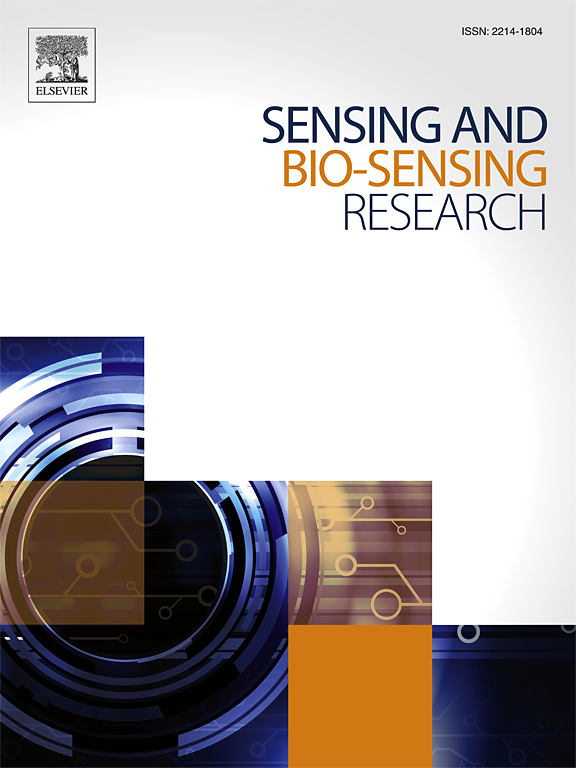Multi-metal oxide/N-doped reduced graphene oxide modified electrode for ultrasensitive determination of phenobarbital
IF 5.4
Q1 CHEMISTRY, ANALYTICAL
引用次数: 0
Abstract
Phenobarbital (PB) is known for its sedative and anticonvulsant characteristics, making it a critical agent for the management of epilepsy and seizure disorders. Considering its narrow therapeutical range, accurate monitoring of this drug is highly recommended to prevent side effects. Herein, we successfully introduced trimetallic graphene oxide-based nanocomposite consisting of cerium oxide, nickel oxide, and copper oxide (III@N-rGO), which benefits the synergistic properties of each compound for electrochemical sensing applications. The structure of the nanostructures was evaluated using Fourier transform infrared spectroscopy (FT-IR), X-ray diffraction pattern (XRD), Raman spectroscopy, field emission scanning electron microscope images (FE-SEM), and transmission electron microscope (TEM). Various electrochemical techniques were employed to investigate the sensor's electrocatalytic performance, following the carbon paste electrode's construction. The target electrode represented superior sensing efficiency, including a broad linear range of 0.1–840 μM, proper sensitivity of 1.389 ± 0.013 mA μM−1 cm−2, low detection limit of 9.10 ± 0.002 nM at the optimum potential of 0.72 V. Furthermore, III@N-rGO electrode illustrated good long-term stability, good reproducibility, and excellent selectivity. The results of recovery tests in human serum and pharmaceutical samples (94–106 %) with desired RSD values (below 3 %) demonstrated the practical applicability of the case-studied sensor. Hence, the proposed platform has the potential to serve as a promising model for PB detection.
多金属氧化物/ n掺杂还原氧化石墨烯修饰电极超灵敏测定苯巴比妥
苯巴比妥(PB)以其镇静和抗惊厥特性而闻名,使其成为治疗癫痫和发作性疾病的关键药物。考虑到其狭窄的治疗范围,强烈建议准确监测该药物,以防止副作用。在此,我们成功地引入了由氧化铈、氧化镍和氧化铜组成的三金属氧化石墨烯基纳米复合材料(III@N-rGO),这有利于每种化合物在电化学传感应用中的协同性能。利用傅里叶变换红外光谱(FT-IR)、x射线衍射图(XRD)、拉曼光谱、场发射扫描电镜(FE-SEM)和透射电镜(TEM)对纳米结构进行了结构表征。在碳糊电极构建完成后,采用多种电化学技术对传感器的电催化性能进行了研究。该电极具有良好的检测效率,线性范围为0.1 ~ 840 μM,灵敏度为1.389±0.013 mA μM−1 cm−2,最佳电位为0.72 V时检出限为9.10±0.002 nM。此外,III@N-rGO电极具有良好的长期稳定性、重复性和选择性。在人血清和药物样品(94 - 106%)中回收率试验的结果具有期望的RSD值(低于3%),证明了案例研究传感器的实际适用性。因此,所提出的平台有潜力作为PB检测的一个有前途的模型。
本文章由计算机程序翻译,如有差异,请以英文原文为准。
求助全文
约1分钟内获得全文
求助全文
来源期刊

Sensing and Bio-Sensing Research
Engineering-Electrical and Electronic Engineering
CiteScore
10.70
自引率
3.80%
发文量
68
审稿时长
87 days
期刊介绍:
Sensing and Bio-Sensing Research is an open access journal dedicated to the research, design, development, and application of bio-sensing and sensing technologies. The editors will accept research papers, reviews, field trials, and validation studies that are of significant relevance. These submissions should describe new concepts, enhance understanding of the field, or offer insights into the practical application, manufacturing, and commercialization of bio-sensing and sensing technologies.
The journal covers a wide range of topics, including sensing principles and mechanisms, new materials development for transducers and recognition components, fabrication technology, and various types of sensors such as optical, electrochemical, mass-sensitive, gas, biosensors, and more. It also includes environmental, process control, and biomedical applications, signal processing, chemometrics, optoelectronic, mechanical, thermal, and magnetic sensors, as well as interface electronics. Additionally, it covers sensor systems and applications, µTAS (Micro Total Analysis Systems), development of solid-state devices for transducing physical signals, and analytical devices incorporating biological materials.
 求助内容:
求助内容: 应助结果提醒方式:
应助结果提醒方式:


